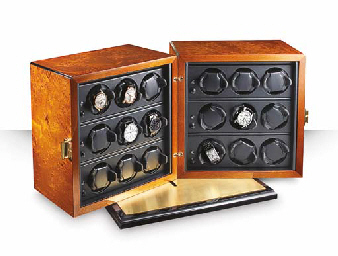A FINE WOOD AND IRON MODEL OF A JAMES WATT CONDENSING BEAM ENGINE OF THE 1780'S, built by G Wilson in 1937, the single cylinder, 1in bore x 4in stroke, is held to wooden crossbeams with four tie-bolts and two bridges. It is jacketed using four segments bolted together, and there are separate valve-chests or "nozzles" with the valve spindle levers driven by "detent levers" actuated by a wooden plug rod placed nearest to the gudgeon. A James Watt cross-arm governor is connected via link-rods to a butterfly valve in the steam main. The double-acting piston rod drives the beam via Watt parallel motion. An inner set of parallel motion maintains vertical movement in the plug rod. Below the cylinder, a cooling-water tank incorporates the separate condenser and air pump which is driven in turn by the tail end of the plug rod. The jet condenser is fed by a header tank mounted on the main trestle frames and incorporates a lift pump. A further lift pump maintains the cooling water level in the tank. Finally, this model illustrates Watts' sun and planet gear driving a square crankshaft, a typical light segmented flywheel and two-part wooden cogged drive-gear. The model is mounted in a York stone-faced pit, height 27in (68.5cm), length 35in (89cm) Fußnoten The frame uses typical tie-bolts, braces and joints and represents the very short period of transition from the art of the blacksmith to that of the engineer where greater precision in manufacture and knowledge of the strength of materials were to rapidly evolve. This key engine represented the cutting edge of technological innovation which lay at the heart of the beginning of the Industrial Revolution, and James Watt's successful partnership with Matthew Boulton at the Soho Foundry. This engine incorporated what are considered to be five of James Watt's most famous inventions. These included the steam jacketed cylinder, conical pendulum, separate condenser, parallel motion and sun and planet crank. Each of these was to form the bedrock of mechanical engineering practice related to the development of the prime mover. James Watt (1736 - 1819) was a Scottish inventor, mechanical engineer, and chemist who improved on Thomas Newcomen's 1712 Newcomen steam engine with his Watt steam engine in 1776, which was fundamental to the changes brought by the Industrial Revolution. NB: A "detent" is a device used to mechanically resist or arrest the rotation of a wheel, axle or spindle. Provenance: Property of The British Engineerium, Hove.
A FINE WOOD AND IRON MODEL OF A JAMES WATT CONDENSING BEAM ENGINE OF THE 1780'S, built by G Wilson in 1937, the single cylinder, 1in bore x 4in stroke, is held to wooden crossbeams with four tie-bolts and two bridges. It is jacketed using four segments bolted together, and there are separate valve-chests or "nozzles" with the valve spindle levers driven by "detent levers" actuated by a wooden plug rod placed nearest to the gudgeon. A James Watt cross-arm governor is connected via link-rods to a butterfly valve in the steam main. The double-acting piston rod drives the beam via Watt parallel motion. An inner set of parallel motion maintains vertical movement in the plug rod. Below the cylinder, a cooling-water tank incorporates the separate condenser and air pump which is driven in turn by the tail end of the plug rod. The jet condenser is fed by a header tank mounted on the main trestle frames and incorporates a lift pump. A further lift pump maintains the cooling water level in the tank. Finally, this model illustrates Watts' sun and planet gear driving a square crankshaft, a typical light segmented flywheel and two-part wooden cogged drive-gear. The model is mounted in a York stone-faced pit, height 27in (68.5cm), length 35in (89cm) Fußnoten The frame uses typical tie-bolts, braces and joints and represents the very short period of transition from the art of the blacksmith to that of the engineer where greater precision in manufacture and knowledge of the strength of materials were to rapidly evolve. This key engine represented the cutting edge of technological innovation which lay at the heart of the beginning of the Industrial Revolution, and James Watt's successful partnership with Matthew Boulton at the Soho Foundry. This engine incorporated what are considered to be five of James Watt's most famous inventions. These included the steam jacketed cylinder, conical pendulum, separate condenser, parallel motion and sun and planet crank. Each of these was to form the bedrock of mechanical engineering practice related to the development of the prime mover. James Watt (1736 - 1819) was a Scottish inventor, mechanical engineer, and chemist who improved on Thomas Newcomen's 1712 Newcomen steam engine with his Watt steam engine in 1776, which was fundamental to the changes brought by the Industrial Revolution. NB: A "detent" is a device used to mechanically resist or arrest the rotation of a wheel, axle or spindle. Provenance: Property of The British Engineerium, Hove.















Testen Sie LotSearch und seine Premium-Features 7 Tage - ohne Kosten!
Lassen Sie sich automatisch über neue Objekte in kommenden Auktionen benachrichtigen.
Suchauftrag anlegen